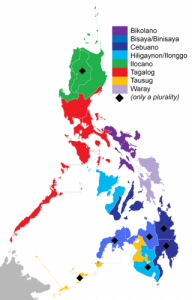Three Things You May Not Know About Ilocano
By Sarah-Claire Jordan
 Ilocano, sometimes spelled Ilokano, is a language native to the Philippines. It is part of the Austronesian language family, which includes Hawaiian, Maori, Indonesian, Tahitian, and more. Ilocano is the third most common language spoken in the Philippines, and has some mutual intelligibility with a few other languages on the islands. It became an official provincial language of La Union in 2012, though the national language of the Republic of the Philippines is (and was) Filipino.
Ilocano, sometimes spelled Ilokano, is a language native to the Philippines. It is part of the Austronesian language family, which includes Hawaiian, Maori, Indonesian, Tahitian, and more. Ilocano is the third most common language spoken in the Philippines, and has some mutual intelligibility with a few other languages on the islands. It became an official provincial language of La Union in 2012, though the national language of the Republic of the Philippines is (and was) Filipino.
The ethnic group that speaks Ilocano is known as the Ilocano people, and they originally lived in the north of Luzon, the largest island of the Philippines. Nowadays, Ilocano people can be found in Central Luzon as well, and all over the world due to immigration. Here are a few important facts about Ilocano and those who speak it:
1. Not all Filipino immigrants in the U.S. speak Filipino
If you know a bit about the Philippines, you would probably know that Filipino is the national language, but that doesn’t mean it’s the only language spoken there. If you come across any Filipino immigrants who arrived any time in the past century, they probably speak Filipino or Tagalog, but that wasn’t always the case. The Ilocano people of northern Luzon were some of the first Filipinos to immigrate to the U.S., bringing their language and culture with them to Hawaii, California, and other parts of the western U.S. In fact, most of the immigrants in the first wave of immigration from the Philippines to the U.S. spoke Ilocano.
2. Ilocano borrows many words from Spanish
Though you can find words borrowed from other languages as well, such as Arabic, Sanskrit, and English, Spanish probably had the greatest influence on Ilocano and other Filipino languages. This is probably largely due to the Spanish colonization of the area, which left marks that are still seen today. Many common phrases in Ilocano sound like slightly modified Spanish, such as the greeting “how are you”, which is “kumusta” in Ilocano and “cómo estás” in Spanish. Days of the week, months, and numbers referring to age are all words that originally were borrowed from Spanish. Numbers for measurement, however, are all native Ilocano words. There are, therefore, two separate number systems: one with native Ilocano words and another with borrowed Spanish words.
3. The oldest story from the Philippines to not be lost or destroyed during colonialism was written in Ilocano
Ilocano literature is rich and varied, but there is one piece in particular that stands out, probably because it survived the Spanish colonial period. It is an epic poem called “Biag ni Lam-ang”, which means “The Life of Lam-ang” in English. It reflects many of the values and beliefs of the Ilocano people, including loyalty, hard work, and the importance of family. The poem was transcribed for the first time around the year 1640 and tells the story of a precocious baby boy who goes off to search for his father after he doesn’t return from battle. The poem goes on to describe the boy’s entire life, including his marriage and death.
For an overview of our translation expertise, visit our telephone interpreting service page
Category: Foreign Language








